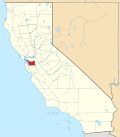San Lorenzo | |
|---|---|
 | |
 Location in Alameda County and the state of California | |
| Coordinates: 37°40′52″N122°07′28″W / 37.68111°N 122.12444°W | |
| Country | |
| State | |
| County | Alameda |
| Government | |
| • State Senate | Aisha Wahab (D) [1] |
| • State Assembly | Liz Ortega (D) [2] |
| • U. S. Congress | Eric Swalwell (D) [3] |
| Area | |
• Total | 3.067 sq mi (7.94 km2) |
| • Land | 3.046 sq mi (7.89 km2) |
| • Water | 0.021 sq mi (0.054 km2) 0.67% |
| Elevation | 36 ft (11 m) |
| Population (2020) [6] | |
• Total | 29,581 |
| • Density | 9,711/sq mi (3,750/km2) |
| Time zone | UTC-8 (Pacific (PST)) |
| • Summer (DST) | UTC-7 (PDT) |
| ZIP code | 94580 |
| Area codes | 510, 341 |
| FIPS code | 06-68112 |
| GNIS feature IDs | 232433, 1659583, 2409260 |
San Lorenzo (Spanish for "Saint Laurence") is a census-designated place (CDP) located in the East Bay of the San Francisco Bay Area in Alameda County, California, United States. The population was 29,581 at the 2020 census. [6] It is an unincorporated community, located at the banks of San Lorenzo Creek. It was originally named Squattersville in 1851, but later renamed to San Lorenzo. [7]
Contents
- History
- Segregation
- Geography
- Demographics
- 2020 census
- Government
- Public education
- References
- External links
In 1944, under contract to the U.S. Navy, The David D. Bohannon Company began construction of San Lorenzo Village, which was one of the nation's first planned communities, with parcels designated for schools, churches, parks, and several retail centers. Bohannon's pioneering pre-cutting techniques, referred to as the "California method," [8] were used in later developments, such as the more famous Levittown, Pennsylvania.




